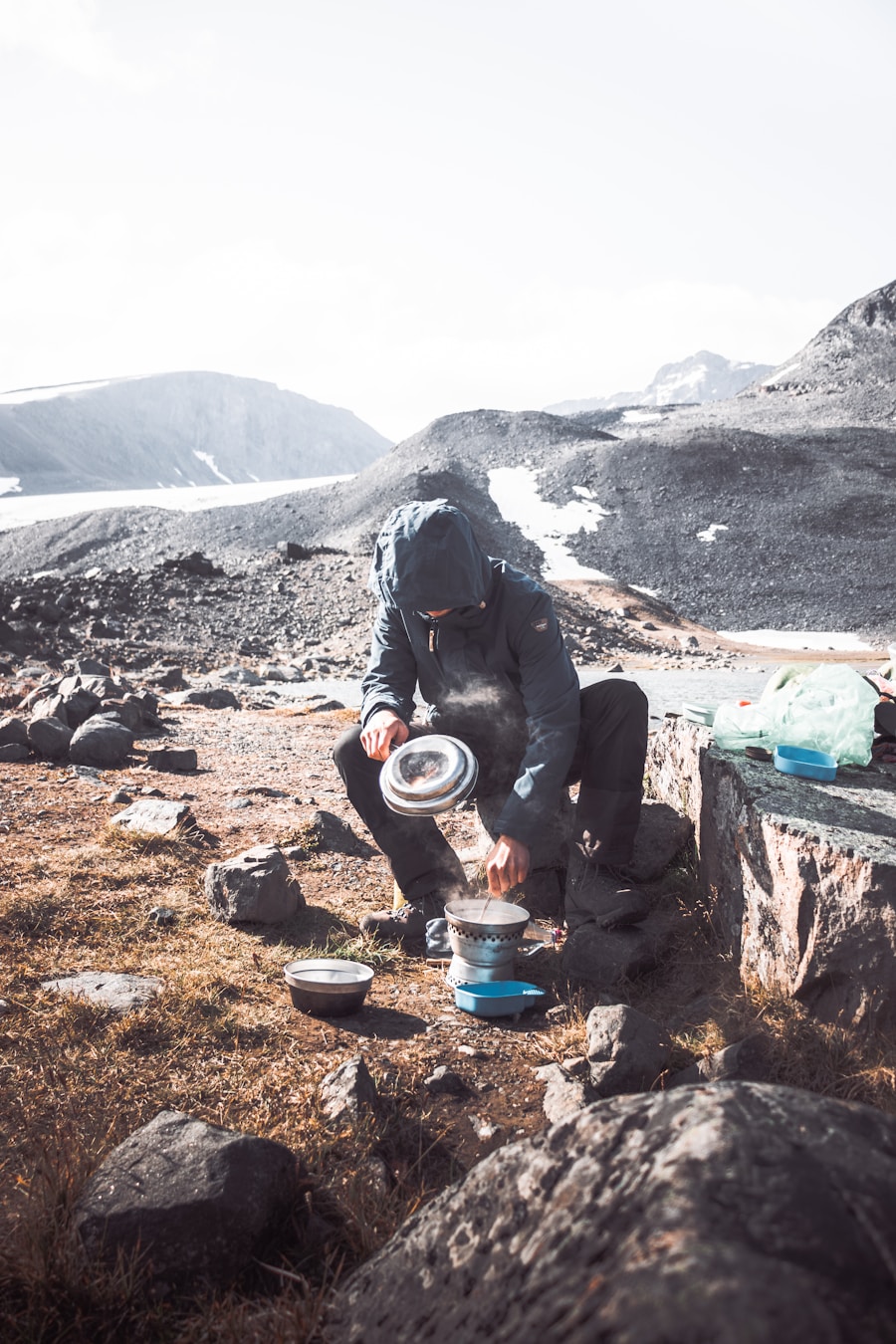High altitude, generally defined as elevations above 8,000 feet (2,400 meters), presents a unique set of challenges for hikers and mountaineers. At these elevations, the atmospheric pressure decreases, leading to a reduction in the amount of oxygen available in the air. This phenomenon can result in a range of physiological effects on the human body, including acute mountain sickness (AMS), which can manifest as headaches, nausea, dizziness, and fatigue.
The risk of AMS increases significantly as one ascends beyond 10,000 feet (3,048 meters), where the body struggles to adapt to the lower oxygen levels. Understanding these effects is crucial for anyone planning to hike in high-altitude environments. The body employs several mechanisms to cope with reduced oxygen availability.
Initially, an increase in breathing rate occurs, allowing for greater oxygen intake. Over time, the body may produce more red blood cells to enhance oxygen transport. However, these adaptations take time, which is why gradual ascent is often recommended.
Additionally, individuals may experience changes in sleep patterns and increased susceptibility to dehydration due to the dry air at high altitudes. Recognizing these physiological responses is essential for hikers to prepare adequately and mitigate potential health risks associated with high-altitude hiking.
Key Takeaways
- Understanding the effects of high altitude: High altitude can lead to symptoms such as headache, nausea, and fatigue due to lower oxygen levels.
- Physical preparation for high altitude hiking: Cardiovascular and strength training are essential to build endurance and muscle strength for high altitude hiking.
- Packing the right gear for high altitude hiking: Essential gear includes layers of clothing, sturdy hiking boots, a reliable backpack, and a high-quality sleeping bag.
- Hydration and nutrition for high altitude hiking: Staying hydrated and consuming a balanced diet rich in carbohydrates, protein, and healthy fats is crucial for energy and recovery at high altitudes.
- Acclimatization techniques for high altitude hiking: Gradual ascent, rest days, and staying well-hydrated can help the body acclimate to high altitudes and reduce the risk of altitude sickness.
Physical Preparation for High Altitude Hiking
Physical preparation is a cornerstone of successful high-altitude hiking. Engaging in a well-rounded fitness regimen that emphasizes cardiovascular endurance, strength training, and flexibility can significantly enhance a hiker’s ability to cope with the rigors of high-altitude environments. Aerobic exercises such as running, cycling, and swimming are particularly beneficial as they improve lung capacity and overall stamina.
Incorporating interval training can also be advantageous, as it mimics the variable intensity of hiking terrain and helps build both aerobic and anaerobic fitness. Strength training should focus on the core and lower body muscles, as these are crucial for maintaining stability and power during ascents and descents. Exercises such as squats, lunges, and deadlifts can help build the necessary muscle strength.
Additionally, flexibility exercises like yoga or dynamic stretching can improve range of motion and reduce the risk of injury. It is also advisable to simulate hiking conditions by incorporating hill workouts or stair climbing into training routines. This not only builds physical endurance but also prepares the body for the specific demands of high-altitude hiking.
Packing the Right Gear for High Altitude Hiking

Selecting appropriate gear is vital for a successful high-altitude hiking experience. The right equipment can make a significant difference in comfort and safety. A well-fitted backpack is essential; it should be lightweight yet spacious enough to carry all necessary items without causing strain.
When choosing clothing, layering is key. Base layers made from moisture-wicking materials help regulate body temperature by keeping sweat away from the skin. Insulating layers, such as fleece or down jackets, provide warmth without adding excessive weight.
Finally, an outer shell that is waterproof and windproof protects against unpredictable weather conditions often encountered at high altitudes. Footwear is another critical component of high-altitude hiking gear. Sturdy, well-ventilated hiking boots with good ankle support are essential for navigating rocky terrain and preventing injuries.
It’s advisable to break in new boots before embarking on a hike to avoid blisters and discomfort. Accessories such as hats, gloves, and sunglasses should not be overlooked; they protect against sun exposure and cold temperatures that can be prevalent at higher elevations. Additionally, carrying trekking poles can provide stability and reduce strain on joints during steep ascents or descents.
Hydration and Nutrition for High Altitude Hiking
| Hydration and Nutrition for High Altitude Hiking | |
|---|---|
| Water Intake | 3-4 liters per day |
| Calories | 3,000-4,000 per day |
| Carbohydrates | 55-65% of total calories |
| Protein | 10-15% of total calories |
| Fat | 20-30% of total calories |
| Electrolytes | Replace lost sodium, potassium, and magnesium |
Hydration plays a crucial role in maintaining performance during high-altitude hikes. The dry air at elevated altitudes can lead to increased fluid loss through respiration and perspiration, making it essential to drink water regularly. Hikers should aim to consume at least three to four liters of water per day, adjusting based on individual needs and exertion levels.
Carrying a hydration system or water bottles that are easily accessible can encourage frequent sipping throughout the hike. Electrolyte supplements or sports drinks can also be beneficial in replenishing lost minerals. Nutrition is equally important when preparing for high-altitude hiking.
A balanced diet rich in carbohydrates, proteins, and healthy fats provides the necessary energy for sustained physical activity. Carbohydrates are particularly vital as they serve as the primary fuel source during intense exertion. Foods such as whole grains, fruits, and vegetables should be staples in a hiker’s diet leading up to the hike.
On the trail, energy-dense snacks like nuts, energy bars, and dried fruits can help maintain energy levels without adding excessive weight to a backpack. It’s also wise to avoid heavy meals before hiking, as they can lead to discomfort and sluggishness.
Acclimatization Techniques for High Altitude Hiking
Acclimatization is a critical process that allows the body to adjust to lower oxygen levels at high altitudes. To minimize the risk of altitude sickness, hikers should ascend gradually whenever possible. A common guideline is to increase elevation by no more than 1,000 feet (300 meters) per day once above 8,000 feet (2,400 meters).
Additionally, incorporating rest days into the itinerary allows the body time to adapt before further ascents. There are several techniques that can aid in acclimatization beyond gradual ascent. One effective method is to spend time at intermediate elevations before reaching higher altitudes; this could involve hiking to a peak and then returning to a lower camp for the night.
This strategy helps stimulate physiological adaptations without overexerting oneself at extreme heights. Staying hydrated and maintaining a balanced diet during this period also supports acclimatization efforts by ensuring that the body has adequate resources to adapt effectively.
Safety Precautions for High Altitude Hiking

Safety should always be a top priority when embarking on high-altitude hikes. One of the most critical precautions is being aware of the signs of altitude sickness and knowing when to descend if symptoms arise. Common symptoms include headache, nausea, fatigue, and difficulty sleeping; recognizing these early warning signs can prevent more severe complications such as high altitude pulmonary edema (HAPE) or high altitude cerebral edema (HACE), both of which require immediate descent and medical attention.
In addition to monitoring health conditions, hikers should also be prepared for sudden weather changes that are common in mountainous regions. Carrying a reliable weather forecast device or app can help hikers stay informed about potential storms or temperature drops. It’s advisable to pack extra layers and emergency gear such as a first aid kit, whistle, flashlight, and emergency blanket in case of unexpected situations.
Establishing a communication plan with fellow hikers or having a means of contacting emergency services can also enhance safety during high-altitude excursions.
Mental Preparation for High Altitude Hiking
Mental preparation is often overlooked but is just as important as physical readiness when it comes to high-altitude hiking. The psychological challenges posed by strenuous hikes at elevation can be significant; feelings of anxiety or self-doubt may arise when faced with steep ascents or adverse weather conditions. Developing mental resilience through visualization techniques can be beneficial; imagining oneself successfully navigating challenging sections of the trail can bolster confidence and reduce anxiety.
Additionally, practicing mindfulness techniques such as deep breathing or meditation can help maintain focus and calmness during strenuous moments on the trail. Setting realistic goals for each day’s hike can also contribute positively to mental well-being; breaking down larger objectives into manageable segments allows hikers to celebrate small victories along the way. Engaging with fellow hikers through shared experiences can foster camaraderie and provide emotional support during challenging moments.
Environmental Considerations for High Altitude Hiking
High-altitude environments are often fragile ecosystems that require careful consideration from hikers. The impact of human activity on these delicate areas can lead to soil erosion, vegetation damage, and wildlife disturbances if not managed responsibly. Adhering to Leave No Trace principles is essential; this includes packing out all trash, minimizing campfire impacts by using established fire rings or portable stoves instead of open fires, and staying on designated trails to prevent habitat degradation.
Moreover, understanding local wildlife regulations is crucial for protecting both animals and their habitats during hikes. Many high-altitude areas are home to sensitive species that may be affected by human presence; respecting wildlife boundaries helps ensure their survival while allowing hikers to enjoy observing them from a distance without causing harm. By being mindful of environmental considerations, hikers contribute positively to preserving these stunning landscapes for future generations while enjoying their own outdoor adventures responsibly.
If you are planning a high altitude hiking trip, it is important to be well-prepared for the challenges that come with it. One essential item to consider is a high-quality sleeping bag, such as the ones recommended in this article on the best sleeping bag for backpacking travel. A good sleeping bag can make all the difference in keeping you warm and comfortable during cold nights at high altitudes. Make sure to choose one that is lightweight, compact, and suitable for the temperatures you will encounter on your hike.
Love travel? Join Our Facebook Community For More Tips.
FAQs
What is considered high altitude for hiking?
High altitude for hiking is generally considered to be any elevation above 8,000 feet (2,400 meters). At this altitude, the air becomes thinner and the body may experience symptoms of altitude sickness.
How can I prepare for high altitude hiking?
To prepare for high altitude hiking, it is important to gradually acclimate to the higher elevation, stay well-hydrated, and maintain a good level of physical fitness. It is also helpful to familiarize yourself with the symptoms of altitude sickness and know how to respond if they occur.
What are the symptoms of altitude sickness?
Symptoms of altitude sickness can include headache, nausea, dizziness, fatigue, and difficulty sleeping. In severe cases, it can lead to high altitude pulmonary edema (HAPE) or high altitude cerebral edema (HACE), which can be life-threatening.
How can I acclimate to high altitude?
To acclimate to high altitude, it is recommended to gradually ascend to higher elevations, allowing the body time to adjust to the thinner air. It is also helpful to stay well-hydrated, avoid alcohol and tobacco, and get plenty of rest.
What should I pack for high altitude hiking?
When preparing for high altitude hiking, it is important to pack plenty of water, high-energy snacks, sunscreen, a hat, and layers of clothing to accommodate for changing weather conditions. It is also recommended to bring a first aid kit and any necessary medications.
